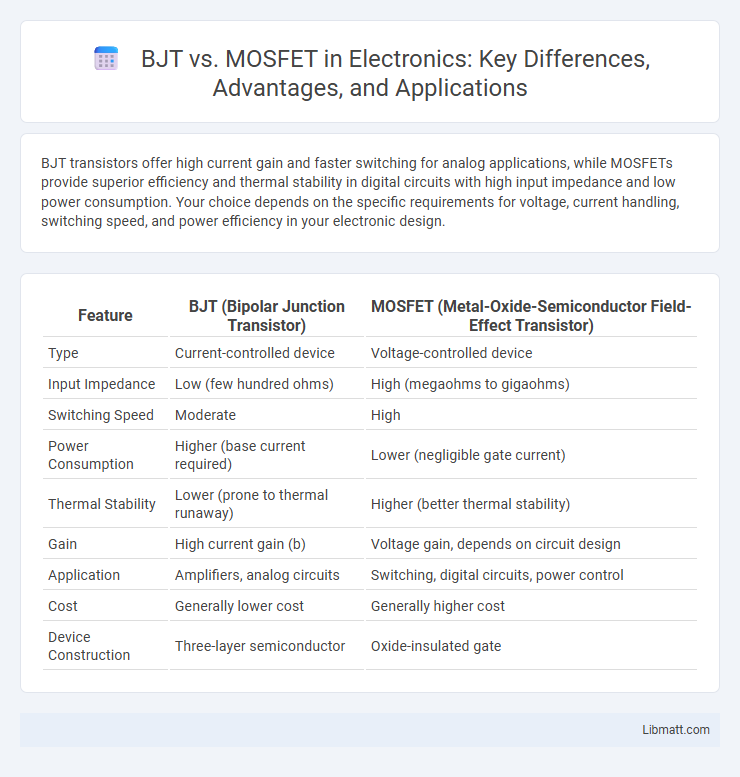BJT transistors offer high current gain and faster switching for analog applications, while MOSFETs provide superior efficiency and thermal stability in digital circuits with high input impedance and low power consumption. Your choice depends on the specific requirements for voltage, current handling, switching speed, and power efficiency in your electronic design.
Table of Comparison
| Feature | BJT (Bipolar Junction Transistor) | MOSFET (Metal-Oxide-Semiconductor Field-Effect Transistor) |
|---|---|---|
| Type | Current-controlled device | Voltage-controlled device |
| Input Impedance | Low (few hundred ohms) | High (megaohms to gigaohms) |
| Switching Speed | Moderate | High |
| Power Consumption | Higher (base current required) | Lower (negligible gate current) |
| Thermal Stability | Lower (prone to thermal runaway) | Higher (better thermal stability) |
| Gain | High current gain (b) | Voltage gain, depends on circuit design |
| Application | Amplifiers, analog circuits | Switching, digital circuits, power control |
| Cost | Generally lower cost | Generally higher cost |
| Device Construction | Three-layer semiconductor | Oxide-insulated gate |
Introduction to BJT and MOSFET
Bipolar Junction Transistors (BJT) operate by controlling current through both electron and hole charge carriers, making them suitable for high-speed switching and amplification in analog circuits. Metal-Oxide-Semiconductor Field-Effect Transistors (MOSFET) control current using an electric field applied to the gate terminal, offering high input impedance and efficient switching for digital applications. Understanding the differences in these fundamental transistor types helps optimize Your circuit design for performance and power efficiency.
Fundamental Operating Principles
BJT (Bipolar Junction Transistor) operates based on current control, where a small base current modulates a larger collector current through the semiconductor junctions. MOSFET (Metal-Oxide-Semiconductor Field-Effect Transistor) functions through voltage control, using an electric field applied to the gate terminal to regulate the conductivity of a channel between source and drain terminals. Understanding these fundamental operating principles helps you choose the optimal transistor type for specific amplification or switching applications.
Structure and Construction Differences
Bipolar Junction Transistors (BJT) consist of three semiconductor layers forming two PN junctions, with current controlled by the base-emitter junction, allowing for minority carrier injection. Metal-Oxide-Semiconductor Field-Effect Transistors (MOSFET) feature a gate insulated by a thin oxide layer above the semiconductor substrate, controlling current flow through an electric field without direct carrier injection. MOSFETs have a simpler layered structure with high input impedance, while BJTs rely on current flow through layered junctions, leading to distinct performance characteristics and applications.
Input and Output Characteristics
BJT (Bipolar Junction Transistor) input characteristics exhibit a high input current due to the base-emitter junction being forward biased, resulting in input impedance typically ranging from 100 to 1000 ohms, while MOSFETs (Metal-Oxide-Semiconductor Field-Effect Transistors) have a voltage-controlled input with near-zero gate current and extremely high input impedance often exceeding 10^12 ohms. In output characteristics, BJTs demonstrate a low output impedance with current-controlled operation suitable for linear amplification, whereas MOSFETs operate with voltage-controlled output showing higher output impedance and are preferred for switching applications due to faster switching speeds and lower power dissipation. The difference in input and output behavior impacts circuit design choices, with BJTs favoring high gain linear circuits and MOSFETs excelling in digital and power-efficient applications.
Switching Speed Comparison
BJT devices generally exhibit slower switching speeds compared to MOSFETs due to charge storage effects in the bipolar junction structure, affecting turn-off times. MOSFETs benefit from majority carrier conduction, allowing faster transitions and higher switching frequencies ideal for high-speed applications. Your choice between BJT and MOSFET should consider switching speed requirements alongside other performance factors.
Power Consumption and Efficiency
BJT devices generally have higher power consumption due to continuous base current flow, whereas MOSFETs exhibit lower power loss because they operate with voltage-controlled gates and negligible gate current. MOSFETs offer superior switching efficiency, making them ideal for high-frequency and low-power applications. Your choice between BJT and MOSFET should consider the trade-off between conduction losses in BJTs and gate drive power in MOSFETs for optimal power efficiency.
Thermal Stability and Reliability
BJT devices exhibit lower thermal stability due to their positive temperature coefficient, which can lead to thermal runaway under high power conditions, impacting reliability in sustained operations. MOSFETs offer superior thermal stability with a negative temperature coefficient, enhancing reliability by reducing the risk of overheating and improving performance in power electronics applications. This reliability advantage makes MOSFETs preferable in high-temperature and high-current environments where consistent thermal management is critical.
Applications in Modern Electronics
BJTs are commonly used in analog circuits such as amplifiers and switching devices where high gain and fast switching are required, particularly in audio and radio frequency applications. MOSFETs dominate in digital electronics, including microprocessors and memory devices, due to their high input impedance and low power consumption. Power electronics increasingly favor MOSFETs for efficient energy conversion in applications like electric vehicles and renewable energy systems.
Cost and Availability Factors
BJTs generally have lower manufacturing costs due to simpler doping and fabrication processes, making them cost-effective for high-volume analog applications. MOSFETs often require more complex gate oxide layers and precise lithography, leading to higher production expenses but greater availability in digital and power electronics markets. Global supply chain factors and market demand also influence the relative pricing and availability of BJTs versus MOSFETs, with MOSFETs dominating in modern electronics due to scalability and energy efficiency.
Choosing Between BJT and MOSFET
Choosing between BJT and MOSFET depends on your specific application requirements, such as switching speed, power efficiency, and thermal performance. MOSFETs offer faster switching speeds and higher input impedance, making them ideal for high-frequency and low-power circuits, while BJTs provide better current handling capability and linear amplification suitable for analog applications. Evaluating your circuit's voltage, current, and control needs will guide you in selecting the most efficient and cost-effective transistor type.
BJT vs MOSFET Infographic

 libmatt.com
libmatt.com